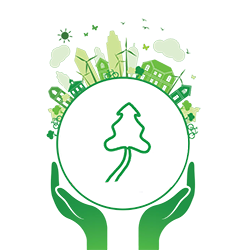
Services
Bio treatment and sludge disposal services are critical components of wastewater management. Let’s explore them in detail:
Sludge Treatment and Disposal:
Sludge, also known as biosolids, accumulates in sewage treatment plants as a by-product of wastewater treatment processes
There are two main types of sludge:
Primary Sludge: Generated from chemical precipitation, sedimentation, and other primary processes.
Secondary Sludge: Resulting from biological treatments, where activated waste biomass is produced.
Goals of Sludge Treatment:
Volume Reduction: Thickening processes reduce sludge volume, making it more manageable.
Stabilization: The aim is to stabilize organic materials, eliminating offensive odors and health hazards.
Treatment Methods:
Thickening: This initial step reduces sludge volume by using gravity or dissolved-air flotation.
Digestion: A biological process where organic solids break down into stable substances. It reduces mass, destroys pathogens, and facilitates dewatering or drying.
Most large sewage treatment plants use a two-stage digestion system, involving anaerobic metabolism by bacteria (in the absence of oxygen)1.
Bio Treatment Services:
Bio-logical Systems: These systems employ biological processes to treat wastewater, breaking down organic matter and removing contaminants.
Tertiary Treatment: Advanced treatment methods that go beyond primary and secondary processes. Examples include filtration, chemical precipitation, and nutrient removal.
Sludge Treatment: Bio treatment also includes managing sludge. Techniques like anaerobic digestion, composting, and thermal hydrolysis are used to stabilize and reduce sludge volume.
Reuse Emphasis: Some bio treatment programs focus on reusing waste products, emphasizing sustainability and environmental responsibility
Local Solutions:
In Qatar, companies like Emvees specialize in providing tailored sludge treatment solutions, including dewatering and disposal
These services contribute to maintaining a clean environment and sustainable water management.
Remember, effective bio treatment and responsible sludge disposal are essential for maintaining healthy ecosystems and safeguarding public health!
Hazardous tank bottom sludge presents unique challenges due to its toxic nature and potential environmental impact. Let’s explore some approaches for its treatment and safe disposal:
Petroleum Sludge Treatment:
Composition: Petroleum sludge (PS) is a solid emulsified waste commonly produced in the petroleum industry. It typically contains varying proportions of oil, water, and solid particles (approximately 30%, 40%, and 30%, respectively).
Challenges: PS is hazardous, corrosive, and harmful to humans, animals, and the environment.
Treatment Approaches:
Conventional Methods: These include biodegradation, landfilling, and incineration. However, they have downsides such as environmental pollution risk and high costs.
Evolving Approaches: Researchers are exploring innovative techniques for PS treatment and disposal.
Cleaning & Recycling Operation for Sludge Tanks:
Objective: The goal is to remove accumulated sediments from tank bottoms efficiently and safely.
Method:
Mild Heating: Apply mild heat to the sediments.
Water-Based Treatment Solution: Combine with a water-based treatment solution.
Result: This combination helps break down and remove sludge from the tank
Safe Disposal Considerations:
Landfill Restrictions: Oily sludges are hazardous wastes and cannot be disposed of in landfills unless they are fully remediated.
Environmental Compliance: Proper disposal involves complying with environmental regulations and identifying suitable final disposal sites
Remember, responsible handling of hazardous sludge is essential to protect both our environment and human health!
Spent catalysts play a crucial role in various industrial processes, particularly in the chemical and oil industries. As these catalysts gradually lose their catalytic activity over time due to structural changes, poisoning, or the deposition of extraneous material, proper management becomes essential.
Here are the options for dealing with spent catalysts:
Regeneration and Reuse:
- Regeneration: If technically feasible, spent catalysts can be regenerated by removing surface coatings and absorbed species, often through burning off.
- Regeneration is environmentally and economically preferred as it extends the catalyst’s use, minimizes raw material consumption, and reduces the need for ultimate recovery or disposal
Use in Another Process:
- Spent catalysts that cannot be regenerated for reuse may find applications in different catalytic or chemical processes. Recycling them within other industrial contexts can be beneficial.
Recovery of Components:
- Some or all of the components in spent catalysts can be recovered. This involves extracting valuable metals or other materials from the spent material.
Disposal:
- If structural changes or severe poisoning effects have occurred within the catalyst during use, rendering regeneration impossible, disposal becomes necessary.
- Proper disposal methods must comply with environmental regulations and local requirements
- Remember, responsible management of spent catalysts contributes to sustainability and environmental stewardship!
Filter cake, a residue generated during various industrial processes, requires proper treatment and disposal. Let’s explore some approaches:
Contaminated Filter Cake:
- In cases where filter cake is contaminated (e.g., heavy metals), specialized treatment is essential.
- Virotec, for instance, provides regulated waste treatment services for heavy metal-contaminated filter cake. Their process includes on-site treatment, transportation, and disposal to licensed regulated waste landfills.
Spent Filter Cake:
- Spent filter cake, often from oil processing plants, presents challenges.
- It can be spontaneously combustible, requiring specific disposal conditions (such as windrows).
- Unfortunately, there is no widely developed technology for spent filter cake recycling
Efficient and Responsible Disposal:
- Proper disposal methods are crucial:
- Landfill Restrictions: Oily sludges, including filter cake, are hazardous wastes and need remediation before landfill disposal.
- Environmental Compliance: Compliance with regulations ensures safe disposal.
- Proper disposal methods are crucial:
Remember, responsible handling and disposal of filter cake contribute to environmental protection!
Contaminated wax or waste wax requires proper handling to minimize its environmental impact. Let’s explore some methods for treatment and disposal:
Importance of Proper Wax Disposal:
- Wax is a versatile material used in various industries, from candles and cosmetics to packaging and coating.
- Environmental Impact: Improper disposal of wax can harm wildlife, water bodies, and air quality. It can also clog drains and sewers, causing infrastructure damage.
- Non-Biodegradable: Wax takes hundreds of years to break down naturally in the environment.
Methods for Recycling and Reusing Wax:
- Recycling: Melting down and purifying wax to remove impurities allows for reuse.
- Cleaned wax can be used to make new products or as a source of fuel.
- Reuse: Old candles can be melted and repurposed to create new ones.
- Organizations Working on Wax Waste Reduction:
- National Candle Association: Promotes safe and efficient use of wax products.
- ReWax: Collects and recycles used wax from the food industry.
- The Wax Cycle: A charity promoting recycling and reuse of wax products in developing countries.
- Recycling: Melting down and purifying wax to remove impurities allows for reuse.
Frequently Asked Questions:
- Is wax biodegradable? No, wax is not biodegradable.
- Can wax be recycled? Yes, by melting and purifying it.
- Are there organizations working to reduce wax waste? Yes, several organizations focus on sustainable wax practices.
Remember, responsible wax disposal contributes to a cleaner environment. Let’s support eco-friendly practices!
Contaminated soil requires proper management to minimize environmental risks. Let’s explore treatment and disposal methods:
Excavation and Treatment:
- Excavation: Contaminated soil is dug up for ex situ (above-ground) treatment or disposal in a landfill.
- Identification: Contaminated areas are identified through research and soil testing.
- Equipment: Standard construction equipment (e.g., backhoes, excavator trackhoes) is used for excavation.
- Safety Measures: Excavations are limited by safety concerns and may involve pumping out water if below the water table.
- Disposal: Excavated soil can be disposed of in a landfill or treated on-site using mobile treatment facilities.
- Cleanup Completion: Soil is considered clean when it meets established cleanup levels.
Treatment Methods:
- Bioremediation: Uses bacteria to break down contaminants in the soil.
- Chemical Oxidation: Converts contaminated soil into non-hazardous soil.
- Soil Stabilization: Adds immobilizing agents to reduce contaminant leachability.
- Physical Methods: Soil washing uses water to separate or remove contaminants.
Thermal Treatment:
- Thermal Desorption: Heats soil to remove volatile organic compounds.
- Incineration: Destroys organic contaminants.
- Thermal Oxidation: Uses high temperatures to break down pollutants.
Reuse and Landscaping:
- Treated soil can be reused on-site or elsewhere.
- After filling in excavated areas, landscaping prevents soil erosion and enhances aesthetics.
Remember, responsible contaminated soil management ensures a cleaner environment and protects human health!
Marine slope oil or waste oil management is crucial for environmental protection. Let’s explore some approaches:
Onboard Recycling:
- About 80% of pollution from ships results from operational oil discharges into the sea, often in violation of international rules due to cost savings or lack of adequate facilities in ports.
- Pyrolysis Process: Researchers are exploring onboard recycling technologies, such as pyrolysis, to obtain marine fuel oil from sludge. Pyrolysis adapts solid waste and biomass treatment to oily waste produced by ships.
- Challenges include energy optimization for efficient onboard use and the lack of mandatory regulations covering onboard waste recycling.
Disposal Regulations:
- Oil or petroleum wastes from engine rooms, pump rooms, and slop tanks must never be discharged into the sea.
- Such wastes should be retained onboard in designated tanks until they can be delivered to reception facilities onshore.
Safe Handling:
- Proper disposal methods are essential to prevent marine pollution.
- Compliance with regulations ensures responsible waste management.
Remember, responsible handling and disposal of marine slope oil and waste oil protect our oceans and marine ecosystems!
Process waste treatment and disposal are critical aspects of managing waste effectively. Let’s explore some major methods used for treating and disposing of various types of waste:
Thermal Treatment:
- Incineration: In this common waste treatment method, waste materials are combusted in the presence of oxygen. Incinerators can recover energy for electricity or heating. It reduces waste volume, transportation costs, and harmful greenhouse gas emissions.
- Gasification and Pyrolysis: These methods decompose organic waste materials by exposing them to high temperatures and low amounts of oxygen. Gasification allows energy recovery without causing air pollution.
- Open Burning: Although environmentally harmful, some local authorities still practice open burning due to its low cost. However, it releases pollutants such as dioxins, carbon monoxide, and volatile organic compounds.
Dumps and Landfills:
- Sanitary Landfills: These are the most commonly used waste disposal sites. They aim to eliminate or reduce environmental and public health hazards associated with waste. Sanitary landfills are carefully designed to prevent water pollution and other risks.
- Controlled Dumps: Similar to sanitary landfills, controlled dumps meet most requirements but may lack certain features. They are a safer alternative to open dumping.
Wastewater Treatment:
- Industrial Wastewater Treatment: Factories, mines, power plants, and commercial facilities treat wet wastes to remove contaminants.
- Sewage Treatment: Urbanized areas handle sewage through centralized treatment systems, ensuring safe disposal of human waste.
Wastewater Treatment Process Steps:
- The wastewater treatment process involves stages such as screening, grit removal, biological treatment, and effluent disposal. Each step contributes to cleaner water
Remember, responsible waste treatment and disposal are essential for environmental protection and public health!
Contaminated grease or waste oil management is essential to prevent environmental harm. Here are some approaches for treating and disposing of contaminated grease:
Avoid Pouring Down Drains:
- Grease should never be poured down drains. Doing so can contaminate surface waters and interfere with sewage treatment systems
- Hot water rinsing: Avoid using hot water to rinse grease off surfaces, as it can still lead to drainage issues.
Proper Disposal Methods:
- Onsite Recycling: Consider recycling waste grease whenever possible. Regeneration and reuse of waste lubricants are growing trends.
- Environmental Impact: Waste grease contains pollutants, so proper disposal is crucial to prevent adverse effects on human health and the environment.
- Efficient Recycling: Recycling waste lubricating greases can help reduce environmental pollution.
Local Regulations:
- Check local regulations regarding grease disposal. Some areas have specific guidelines for handling and recycling waste grease.
- Avoid Open Burning: Open burning of grease is harmful and should be avoided due to air pollution risks.
Remember, responsible grease disposal protects our environment and ensures a cleaner future!
